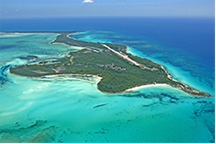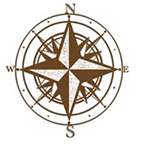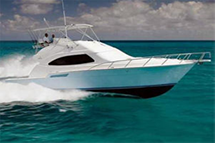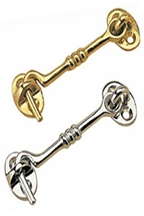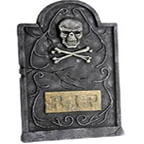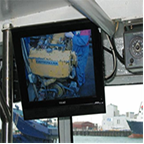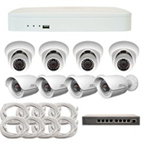I grew up in a nautical family and was raised on the Loxahatchee River, in Jupiter Florida. The principal from Jupiter Middle School had to call my father on more than one occasion to tell him to not let me fish before school at the bus stop. The Island Way Bridge was a favorite spot of mine and the Eagles Nest docks worked just as well. The phone call from the principal was purely from a hygiene perspective as I was covered in fish scales many mornings and couldn’t care less.
As almost any experienced sailor or boating enthusiast will tell you that disaster is always lurking on the horizon. I have encountered 25 foot plus seas, engine loss, fire, navigation equipment failure, running aground but the most harrowing experience that I have ever encountered was being trapped in an engine room. I had the unfortunate experience of being stuck for over an hour plus with twin Caterpillar 1600 Horse Power Engines screaming in my ears.
In my spare time I used to be a first mate on a 54 foot tournament rigged Bertram sport fishing yacht called the Spinal Fusion. This terrifying incident happened almost 15 years ago. We were coming back from the Walkers Cay Fishing Tournament in the Bahamas. My best friend Captain Chad Grady was the captain on this vessel and I assumed the duties of First Officer (aka First Mate). We had a successful trip and placed in multiple categories including second largest wahoo (39lbs) and third largest dolphin (32lb bull). On the same trip we also released a Blue Marlin and released more sailfish than we could count along with icing down a few blue fin tunas. We always kept soy sauce on the boat as tuna usually finds the fillet knife within minutes of being caught.
The tournament is 3 days long but the owner of the vessel loved to Island Hop. Before and after the tournament we hit a few remote islands on the northern end of the Abaco’s (Green Turtle, Great Guana Cay, Hope Town, and Treasure Cay). Great Guana Cay has a drink called the Guana Grabber that makes the popular Bahamian Goombay Smash seem like a Shirley Temple. Growing up I visited these Islands many times and know a lot of the nooks and crannies to find the best fishing grounds (Honey Holes). I ate more Conch Chowder and Lobster than one could imagine. Yellowtail snapper, Red Snapper and Nassau Grouper are abundant and ripe for the taking all year long. A good rule of thumb is to only take what you are going to eat plus a little for the freezer back home.
After a 10 day trip of fishing (spear fishing, trolling, deep sea, lobstering and conching) it was time to come home. We dropped Dr. Charles S. Theofilos, MD and his family, 3 sons a wife and 2 nannies in Marsh Harbor, Bahamas. The boat was named after a surgical procedure (Spinal Fusion) which he was the foremost neurological specialist in this field. He developed a few techniques which are widely practiced today.
Believe it or not after spending this much time in paradise eating like a king, you crave to be at home. During this trip your diet consist of all different varieties of fish. You long for a “Cheeseburger Not In Paradise”, preferably stateside with real water not the kind that is desalinated. Desalinated water leaves the worst taste in your mouth. After huffing diesel fumes all week and drinking desalinated water your taste buds take weeks to recover.
Looking at our 190 plus mile voyage home we decided to split our trip into 2 separate days since it was getting late. As we left Hope Town the Doctor buzzed his boat in a private plane at a very low altitude. This was common practice for him to do and we usually flipped him off or mooned him. We grabbed a few clear becks bottles (not sold in US due to high alcohol content) and headed for Doubled Breasted Cay as an anchoring point for the night. Double Breasted Cay is the northern most Island in the Bahamas and it has 2 small islands that form an inlet in the middle of nowhere. They are really just large sand bars where the water drops to 600 feet deep yards from the shoreline. They are uninhabited and have zero amenities and maybe just a few mangroves poking out here and there. Walkers Cay is your closest island which is now uninhabited and closed since the Hurricanes (Hurricane Frances, Hurricane Jean) in September 2004. Our nation’s most famous and deadly Hurricane, Katrina happened a year later.
We woke up early the next morning while it was still dark and finished off the rest of our conch salad. It was now officially time to go home. While Chad nursed a slight hangover I took the helm and headed due west at 250 degrees. Though I am not a licensed Captain, I can navigate by dead reckoning and this morning with it still being dark, I used the oldest method known Celestial Navigation. Without a complete working knowledge of this particular chart plotter (way before GPS became the norm), I used methods I was taught as a youth. You use the moon and sun along with certain stars against the horizon. I would practice this when I was younger on my grandfather’s sailboats which can be boring while moving at a glacial pace just faster than a snail. I prefer the roar of a power boat to a sailboat. Even though I garnered most of my nautical skills from my Grandfather who taught me proper seamanship on many lengthy trips to the Bahamas.
After piloting the boat for a few hours solo and somewhere in the middle of the Atlantic Ocean miles from any shoreline or sight of land. I went down below and found Captain Chad snoring. I was hungry and needed something to eat and drink. So I woke him up hoping that he would assume his duties as the Captain. I really just wanted something to eat, I could have piloted the boat all the way home. Periodically on long trips it is always wise to check the engines and generator down below. The slighting Captain ordered me harshly at that moment to do this because I woke him from his slumber. You cannot always trust your instruments and overheating is something that happens far too often on boats.
As I went down below through a hatch lid that has a hook and eye to keep it firmly secured. I lifted the hatch which has two hydraulic arms on each side of this heavy fiberglass lid that keep the hatch cover hoisted up in the upright position. The hatch lid is above and has a door on the front that is hinged separately. With Captain Chad cruising at about 30 knots in the 54 Convertible Bertram, I proceeded down below. After checking the engine temperatures and generator I heard a repeated loud thumping sound and looked to see the engine room hatch bouncing about wildly. As we entered the gulfstream the waves picked up considerably. Chad was having fun bashing through the waves and launching airs in this beautiful multi-million dollar yacht. Meanwhile as the hatch was bouncing around and the noise suddenly stopped. The bright sun light that was beaming in ceased and only 1 small engine room light was lit. I headed to the hatch and pushed up and the hatch wouldn’t budge.
Somehow the latch hook unluckily found its way into the eye receptacle of the female end. The noise in the engine room was ear splitting and the heat immediately started rising with the door closed. I was screaming and pounding on the hatch to no avail. There is not much room in most engine rooms besides a small walk way and a majority of the boats operational equipment crowds out any extra space. I looked around and grabbed a flash light and them some paper towels to fashion homemade ear plugs. Now that I was partially deaf I decided to turn off the generator to get Captain Grady’s attention. Too bad for me that the boat just had 2 industrial sized marine batteries installed that are meant to run for weeks without generator power. The master control electrical panel is located in the salon of the boat so I couldn’t disable any of the boats main systems. I thought about turning off the sea cocks to disable the water from cooling the engines. This would also cause the engine room to overheat along with me too.
As my Claustrophobia really started setting in coupled with the unbearable heat and noise, I thought to myself how nice a slow sail boat crossing would be under the power of sail. I briefly thought of the sound you hear in a sailboat with no motors and how peaceful it is to be cruising at 10 knots being powered by Mother Nature.
I stopped sweating at this point because all my fluids had been exhausted and was experiencing mild heat stroke symptoms. I looked at the water desalinization machine and thought wow, how lucky am I. Wrong, as I unhook one of 2 tubes it started gushing water and in my excitement I lowered my head and was treated to big gulp of salt water. I removed the intake as opposed to the one that goes to all the faucets and bathrooms throughout the boat. Now my eyes are watering and I am getting real dizzy and having a chocking/coughing fit. Have you ever had a big gulp of warm salt water?
I thought to myself is this how I am going to die, trapped in an engine room? I decide to head over to the ladder at the bottom of the hatch door and lay down and conserve what little energy I had left. After about 30 more minutes the boat came to an idle. I started screaming again but nothing came out, my throat was raspy from previous attempts at prolonged screaming and my salt water smoothie did little to help. Banging the hatch door with a hard scrub brush was my feeble attempt at an SOS. Even with the engines idling it was still as loud as a rock concert. Finally the Captain was looking for me. He came down the fly bridge and opened the hatch. I barely had any energy left and crawled out onto the deck floor and collapsed.
Hours later we cleared customs and docked the boat behind the Doctors house in Palm Beach Gardens. When Dr. Theofilos found out what happened he immediately asked Captain Chad Grady what could be done to improve the safety. He was told that a lot of newer boats come equipped with a CCTV engine room security surveillance camera with a monitor that is viewable from the Fly Bridge. Thankfully for me Captain Chad Grady owns Palm Beach Marine Electronics and this was a relatively simple task that I helped him accomplish. This was done by running a power line to the marine electrical panel and a coaxial cable to the fly bridge along with the mounting of a monitor that all connected to the CCTV Surveillance Security Camera. This was all done in about the same time that I was trapped in the engine room. This simple Marine Surveillance CCTV Camera System was purchased and installed for around $400.
With improvements in the CCTV Camera field DVRs and NVRs are becoming common place on bigger yachts and pleasure boats. The most applied use is to view the Engine Room with a Security Surveillance Camera. The latest technological advances in the CCTV Industry have the Marine Security Surveillance Cameras being used to view the many rooms and different areas found on and around these larger boats including the dock. You can keep an eye on the crew along with the boats guest. Having this added safety feature on your Marine Vessel comes with many advantages. Preventing theft and being able to monitor your vessel at all times remotely gives you a great peace of mind. The majority of a boats life happens right at the dock and this is where most theft and crime occurs unless you find yourself in the Somali Straights off Africa. Captain Richard Phillips was rescued by Navy Seals after his vessel the Maersk Alabama was hijacked by pirates. Modern day pirates have been operating in the Caribbean for years before this incident.
Not all uses of the Digital Video Recorder and Network Video Recorder have a negative connotation linking them to nefarious actions. These Marine CCTV Surveillance Cameras are now being widely implemented in the marine tourist industry. A growing number of fishing charters are installing them so family and friends can watch remotely as you reel in a trophy fish. They have also started popping up on Parasailing boats with the ability to use a PTZ (Pan Tilt Zoom) Camera, you can clearly see yourself from 200 feet away.
The average stop at the fuel pump on a 50 foot boat with 1500 gallon tanks runs you around 7 or 8 grand at $5 a gallon stateside. In the Bahamas that number doubles. Not having a CCTV Security Surveillance System on these large boats is not due to expense but rather not being informed of the advantages. Whether these benefits are for a lifesaving purpose or pure enjoyment of viewing memorable moments from a vacation. Having a CCTV Security Camera System is a no brainer in an industry where spending money is not an issue. One of the oldest saying amongst boaters is that boats are “holes in the water, into which you throw money”.
I found a reputable source (www.securitycameraking.com) that has tiny NVR Security Surveillance Systems which can be tucked away and hidden nicely in these larger sport fishing vessels. This NVR Security Package is under 2 grand and comes with everything needed to complete your security needs. They offer extensive 3 year warranties which is unheard of in the electronics world. I hope you have found this information useful.

